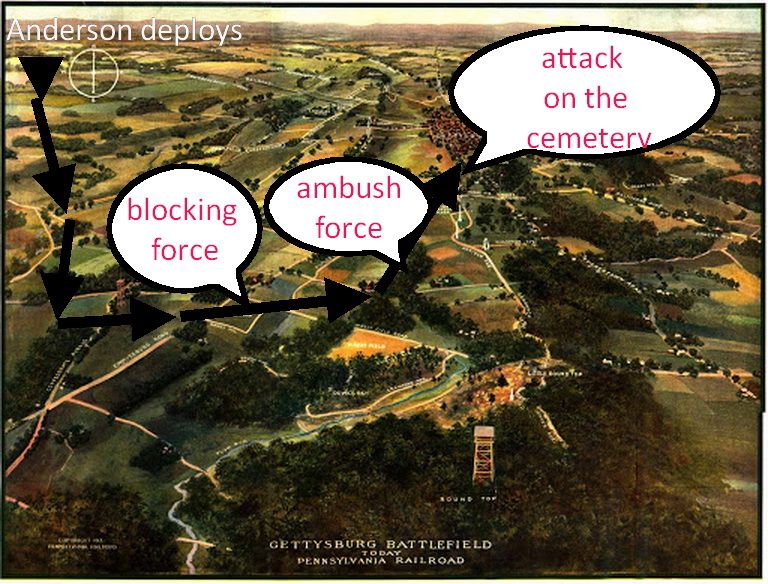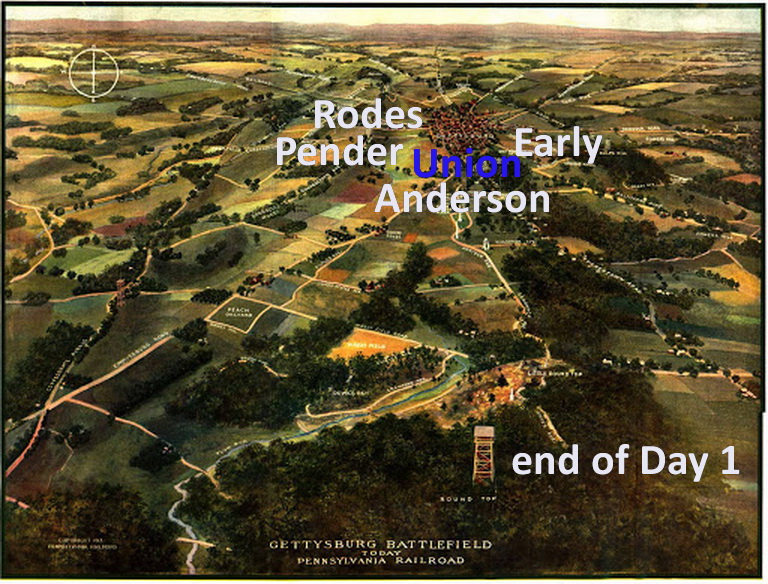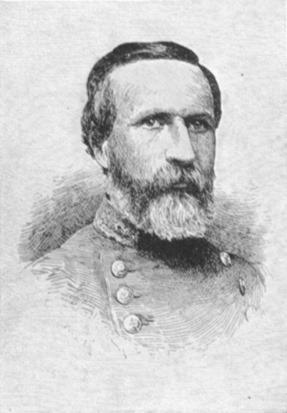Herein I propose a series of actions that Anderson could (would?) have taken if Lee had deployed him south to interdict further Union forces. If we stipulate that it would have been at least 2PM before his division turned to corner at the tip of Seminary Ridge, then 1st & 11th Union Corps were already on the battle field. Hancock’s Second Corps was soon to arrive via the Taneytown Road. It is quite likely that the first Union troops he encountered would have been the wagon masters trailing the 1st and 11th. He would have needed to dispose of (take as POWs) those in his path and to interdict those still moving north. A small cavalry detachment could likely have done the latter. That same cavalry would then scout farther south to detect any infantry on the move. Next he would need to place some artillery and perhaps 2-3 regiments of infantry on the orchard knoll as a blocking force. Third, he’d have established a look-out station on Big Round Top (BRT) with overwatch of the three main routes from the south. His main issue at that point was for them to communicate any findings.
Knowing that there were no Union troops arriving via the Emmittsburg Road any time soon, he’d move his main force over to Little Round Top (LRT) and establish a flank ambush position overlooking the road from Taneytown. Since LRT was too rocky and steep for easy artillery access, he’d place them in the area of the saddle between the two ridges.
Of course, he’d need to send scouts and skirmishers north and east to get an overview of the terrain. Undoubtedly, he’d soon receive word that there was a small Union force occupying a cemetery just a few hundred yards north of his position. Since they were busy preparing defensive positions, they were completely focused to the north and west and were, as yet, unaware of his presence.

A commander never likes to split his force, but he also cannot allow an enemy force so near his rear. I’d suggest that he would establish a three regiment attack force to move north. The lead regiment would move along the crest of Cemetery Ridge with one regiment moving on the lower ground on either side. A dedicated three-gun battery could have provided cover from the far south end of that ridge. It would be a bit dangerous to fire over the heads of the lead regiment but if solid shot rather than explosive rounds were used they could wreak havoc in the cemetery without endangering his men.
The plan would be a three-pronged attack into the rear of that Union force, hopefully with the complete element of surprise. A few rounds of solid shot would increase the chaos as the infantry attacked. However, the regiment on the right flank would encounter something quite unexpected: at a small farm house just below the cemetery they would find the lightly armed staff of no less than three senior Union Generals. Hancock, Howard and Sickles were now prisoners! He would not know it for some time, but MG Doubleday who took over 1st Corps from the deceased LTG Reynolds was now the senior commander on the battle field!
Anderson, himself, would have been summoned to the Union HQ to formally accept the surrender of that group of officers. Once the small contingent working in the cemetery had been disposed of (killed, wounded or captured), the CSA soldiers would take their place in the trenches. The artillerymen from the 3-gun battery would be called forward to assume control of the captured Union cannons and begin to instruct the infantrymen in their operation. Then the waiting game would begin. It would be obvious to these West Point graduates that this cemetery was going to be the assembly point as the day’s battle wound down at dusk. Regardless of the outcome, the Union force was headed their way!
Anderson would then be faced with a major decision. How could he defend in two directions? Undoubtedly more Union formations would be arriving from the south and soon two Union Corps would be moving through the city at his north. Should he move at least one brigade up to the cemetery area, leaving the others to spring the ambush?
Fortunately for command and control purposes, Anderson’s 7000–man division was organized into five brigades rather than the traditional three. His smallest, under COL Lang was comprised of only three regiments and was left in the orchard as the blocking force. The next smallest (also three-plus regiments) under BG Wright was now occupying the cemetery. That left him with three full-strength brigades — roughly 1500 men each
Seemingly two would be enough to leave on LTR as the ambush force and one would be called to move to the left of the cemetery thereby establishing a blocking force astride the Emmittsburg Rd near where it entered the city. He’d also call up one of his Artillery regiments to add to the captured guns, leaving two at the ambush site.
His last act would be to send messengers on the most direct route over the Seminary Ridge to inform LTG Hill of his status (and prisoners) and to request re-enforcements with all due haste.
As all this was taking place, he would have become aware that while the sounds of the battle to his west where Heth had been engaged all day were quieting down, the rumble of cannon fire to the north of the city was increasing. This would signal that LTG Ewell’s Corps had joined the fray. Dusk would soon be upon them and the survivors of the two Union Corps would be headed his way. Indeed, it was in the late afternoon that MG Rodes finally coordinated his attack with Heth’s left flank units and they launched their most successful effort of the day at the angle where 1st and 11th Corps abutted. Simultaneously, MG Early was in the process of routing the 11th Corps right flank and disrupting the entire Union line. One by one regiments left the line either into the city or marching down the west side headed for the cemetery. First Corps units were depleted, tired and low on ammunition. Eleventh Corps was in better physical shape but many had fled the line in disarray. None had any idea what lay before them.
It is not precisely recorded as to when the Second Corps infantry formation marched into the ambush as they emerged from the shadow of BRT, but it is quite likely that Anderson would have been fighting two separate actions simultaneously.
We also know that it was late afternoon when Lee returned to the battle front. He would then have had to act quickly to move Pender’s division (now under the command of MG Pettigrew replacing the mortally wounded Pender) into position at the north end of Seminary Ridge to further interdict the retreating 1st Corps units. It was only a few hundred yards from the Seminary to the cemetery but it is unlikely that there would have been any real opportunity for Pender and Anderson to directly link up. Perhaps the best that Anderson could have done was to align a brigade to the left of the cemetery straddling the Emmittsburg Road and thereby closing the gap between himself and Pender.

To close this lengthy chapter of ALT Hx, Lee’s decision to deploy Anderson to the south would most likely have resulted in him achieving the major victory that he sought. First, Eleventh and Second Union Corps would have been annihilated as a fighting force. Meade would likely have been able to recall the other four Corps to Pipe Creek.
Whether the major losses at Gettysburg alone would have been sufficient to force Lincoln to the negotiating table or if Lee would have to fight on at Pipe Creek and Westminster will have to remain unanswered. In short, Lee could have achieved victory had he made one small but decisive move!
Part 2 Against all odds
Deploying Anderson’s Division would have gone against the conventional wisdom of the era. It was common practice to hold up to a third of one’s forces in reserve. This applied at all levels of command. At mid-morning on Day 1, Lee gave LTG AP Hill permission to deploy Pender’s Division to support Heth who was fully engaged. Because Anderson’s Division was still back near Cashtown, he was essentially held in ‘reserve’. Within a deployed division, at least one brigade would be so designated; within a brigade, at least one regiment. In modern day parlance, these could serve as a Quick Reaction Force. They could engage to help exploit a breakthrough or to assist a unit under threat.
So for Lee to have committed Anderson to a flanking operation would have gone against his better judgement. But at the same time, there really wasn’t sufficient maneuver space in the battlefield selected by BG Buford for Lee to have committed Anderson there.
I contend that had Lee not been feeling the effects of his angina on that morning, he might have been thinking more clearly and have acted boldly enough to commit Anderson as described above. On the other side of the argument is the fact that he truly had no idea what strength of a Union force he was facing at that hour. MG Stuart had failed him by not providing reports of Union troops strength and movements. CSA spy Harrison’s reports were accurate but non-specific. If there was only cavalry battling Heth, infantry had to have been in the area. But where? How many and how close.
Seemingly Lee was true to form that morning. It seemed to him, even from his short and distant observation of the battle as it was progressing, that Heth had things well in control and that by adding Pender he could ensure that the ANV would carry the day. He also knew that Ewell’s Corps was converging from both north (Rodes) and east (Early) and surely four ANV division would prevail over whatever the Union could march into the area.
Yet the speculation remains that a south-easterly deployment of Anderson into the route of march of Union forces approaching from the south could have completely changed the tide of the war! Lee’s lack of data (intelligence) concerning Union troop movements and more importantly the terrain east of Seminary Ridge were his down-fall.

